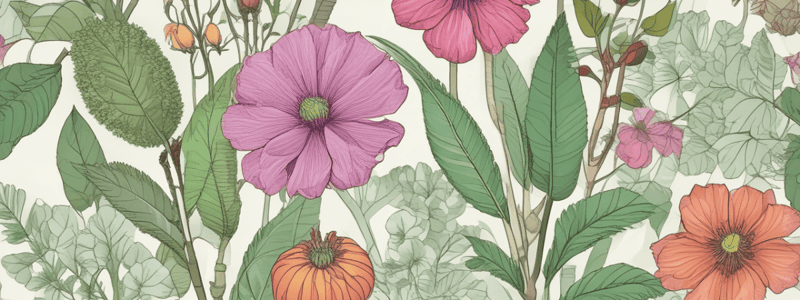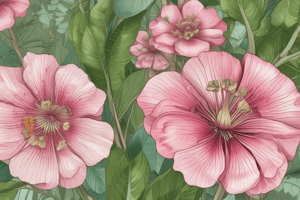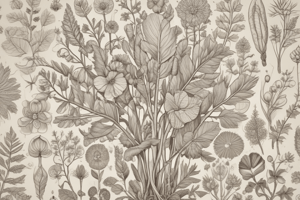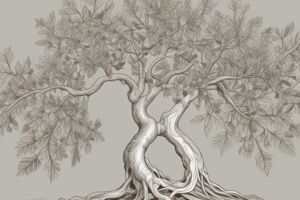Podcast
Questions and Answers
What type of vascular bundle arrangement do herbaceous dicots have in their stems?
What type of vascular bundle arrangement do herbaceous dicots have in their stems?
Discrete vascular bundles arranged in a cylinder
Where does the vascular cambium arise in herbaceous dicot stems?
Where does the vascular cambium arise in herbaceous dicot stems?
Between primary xylem and primary phloem
What does the vascular cambium add to herbaceous dicot stems?
What does the vascular cambium add to herbaceous dicot stems?
Secondary xylem and secondary phloem
What does one year's growth of xylem in woody dicot stems form?
What does one year's growth of xylem in woody dicot stems form?
What do the annual rings of wood in woody dicot stems indicate?
What do the annual rings of wood in woody dicot stems indicate?
What is the function of cork cambium in many plants?
What is the function of cork cambium in many plants?
What is the area of the stem where leaves are attached called?
What is the area of the stem where leaves are attached called?
What is the angle between petiole and stem called?
What is the angle between petiole and stem called?
What marks the vascular tissue arrangement on a twig?
What marks the vascular tissue arrangement on a twig?
What do deciduous trees and shrubs lose annually?
What do deciduous trees and shrubs lose annually?
What does the number of groups of bud scale scars on a twig tell?
What does the number of groups of bud scale scars on a twig tell?
What are the often leaflike appendages at the base of a leaf called?
What are the often leaflike appendages at the base of a leaf called?
What is the main function of the apical meristem at the stem tip?
What is the main function of the apical meristem at the stem tip?
What are the three primary meristems formed from the apical meristem cells?
What are the three primary meristems formed from the apical meristem cells?
What develops from the leaf primordia and bud primordia?
What develops from the leaf primordia and bud primordia?
What is a trace, and what does it lead to in the stem?
What is a trace, and what does it lead to in the stem?
What protects the apical meristem before the growing season begins?
What protects the apical meristem before the growing season begins?
What is the primary function of the vascular cambium in woody dicotyledonous stems?
What is the primary function of the vascular cambium in woody dicotyledonous stems?
How does the wood produced in spring differ from the wood produced later in the season?
How does the wood produced in spring differ from the wood produced later in the season?
What is the primary component of bark in woody dicotyledonous stems?
What is the primary component of bark in woody dicotyledonous stems?
How does the structure of wood in conifers differ from that in dicotyledonous plants?
How does the structure of wood in conifers differ from that in dicotyledonous plants?
What is the primary function of the cork cambium in woody dicotyledonous stems?
What is the primary function of the cork cambium in woody dicotyledonous stems?
What are laticifers and what do they secrete?
What are laticifers and what do they secrete?
What is the difference between softwood and hardwood?
What is the difference between softwood and hardwood?
What are resin canals and where are they found?
What are resin canals and where are they found?
What are tyloses and what is their function?
What are tyloses and what is their function?
Describe the two types of wood sawing patterns.
Describe the two types of wood sawing patterns.
What are the main components of dry wood and what affects its density and durability?
What are the main components of dry wood and what affects its density and durability?
What are the three primary meristems formed from the apical meristem cells?
What are the three primary meristems formed from the apical meristem cells?
What develops from the leaf primordia and bud primordia?
What develops from the leaf primordia and bud primordia?
What is a trace, and what does it lead to in the stem?
What is a trace, and what does it lead to in the stem?
What protects the apical meristem before the growing season begins?
What protects the apical meristem before the growing season begins?
What forms the leaf gap or bud gap in the vascular cylinder of the stem?
What forms the leaf gap or bud gap in the vascular cylinder of the stem?
What is the name of the tissue responsible for secondary growth in woody dicotyledonous stems?
What is the name of the tissue responsible for secondary growth in woody dicotyledonous stems?
What are the two types of wood produced in woody dicotyledonous stems based on the activity of vascular cambium and cork cambium?
What are the two types of wood produced in woody dicotyledonous stems based on the activity of vascular cambium and cork cambium?
What is the name of the tissue found outside the vascular cambium in woody dicotyledonous stems?
What is the name of the tissue found outside the vascular cambium in woody dicotyledonous stems?
What is the main component of mature bark in woody dicotyledonous stems?
What is the main component of mature bark in woody dicotyledonous stems?
What are the vessel elements produced in the secondary xylem of woody dicotyledonous stems after spring wood?
What are the vessel elements produced in the secondary xylem of woody dicotyledonous stems after spring wood?
What is the central cylinder of primary xylem, primary phloem, and pith (if present) in plant stems called?
What is the central cylinder of primary xylem, primary phloem, and pith (if present) in plant stems called?
What are the two main types of flowering plants based on the number of cotyledons (seed leaves) they have?
What are the two main types of flowering plants based on the number of cotyledons (seed leaves) they have?
How do the vascular bundles in monocot stems differ from those in dicot stems?
How do the vascular bundles in monocot stems differ from those in dicot stems?
What are the main components of a typical monocot vascular bundle?
What are the main components of a typical monocot vascular bundle?
What is the function of the first formed xylem cells in monocot stems?
What is the function of the first formed xylem cells in monocot stems?
What is the primary function of the vascular cambium in woody dicotyledonous stems?
What is the primary function of the vascular cambium in woody dicotyledonous stems?
What is the main function of vascular rays in woody dicotyledonous stems?
What is the main function of vascular rays in woody dicotyledonous stems?
What does one year's growth of xylem in woody dicotyledonous stems form?
What does one year's growth of xylem in woody dicotyledonous stems form?
What do the annual rings of wood in woody dicot stems indicate?
What do the annual rings of wood in woody dicot stems indicate?
What is the primary function of the cork cambium in many plants?
What is the primary function of the cork cambium in many plants?
What type of vascular bundle arrangement do herbaceous dicotyledonous stems have?
What type of vascular bundle arrangement do herbaceous dicotyledonous stems have?
What does the vascular cambium add to herbaceous dicotyledonous stems?
What does the vascular cambium add to herbaceous dicotyledonous stems?
What are the primary components of dry wood and how do they affect its density and durability?
What are the primary components of dry wood and how do they affect its density and durability?
What are resin canals and where are they found?
What are resin canals and where are they found?
What are tyloses and what is their function?
What are tyloses and what is their function?
How does the structure of wood in conifers (softwood) differ from that in dicotyledonous plants (hardwood)?
How does the structure of wood in conifers (softwood) differ from that in dicotyledonous plants (hardwood)?
What are the two main types of sawing patterns used for wood, and how do they differ?
What are the two main types of sawing patterns used for wood, and how do they differ?
What are laticifers and what do they secrete?
What are laticifers and what do they secrete?
Flashcards are hidden until you start studying




